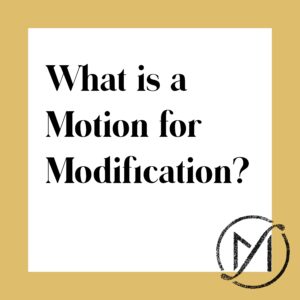Updated November 27, 2023
One of the questions many people have is “What is a Motion for Modification?” When the court finalized your divorce, it issued a divorce decree. That divorce decree is a final, enforceable court order. The majority of people do what the court order requires (especially when they reached an out of court agreement that became the court’s order).
But life changes and it’s impossible for a divorce decree to take into account every possible scenario. Sometimes, you will want to make changes to the court’s order. This is called “modification” and is generally done via a Motion to Modify.
Read on to learn more.
Modification Basics
A Motion to Modify is one of the most common Post Judgment motions in Connecticut. You file a Motion to Modify when you seek to change financial elements of a divorce decree, such as the amount set for child support or alimony. You may need a modification if, for example, you lose a job, get a new job, or experience a significant life change. A Motion to Modify may also be used to adjust the terms of a parenting plan or custody agreement so that they more accurately reflect your child’s needs as they grow.
In some cases, a Motion for Modification will be filed “pendente lite,” or while your divorce is pending. The court may put orders in place during your divorce, and a pendente lite Motion to Modify seeks to modify those orders.
This motion does not apply to property division. If you’d prefer to reach an agreement rather than litigate, mediation and collaborative law are options to consider. In those cases, we submit the agreement you reach to the court so that it becomes an enforceable court order.
When Will the Court Modify Alimony?
The court cannot order alimony in the future if alimony if it didn’t order alimony in the divorce. If it was, the next question is whether the divorce order specifically prohibits modification of alimony. In cases where the order is silent on modification, alimony may be increased, decreased, or eliminated when there is a substantial change in circumstances of either ex-spouse. Sometimes a Motion for Modification of Alimony is based on a spouse’s remarriage or cohabitation with a new partner.
What is a “Substantial Change in Circumstances” for an Alimony Modification?
To determine whether there has been a substantial change in circumstances, courts compare the circumstances at the time of the last alimony order with circumstances at the time that a party seeks a modification. A minor income fluctuation alone generally isn’t a “substantial change in circumstances.” Also, an increase in the income of the alimony payor alone generally isn’t enough to modify an alimony award upward.
When Will the Court Modify Child Support?
There is no automatic recalculation of child support, you have to file a Motion for Modification to try to change it.
As with alimony, the parent who wants to modify an existing child support order must show a “substantial change in circumstances.”
Some examples of changes that might justify child support modification include:
- an increase (or decrease) in one parent’s income
- an increased need for support
- or a permanent change parenting plan
What is a Substantial Change in Circumstances for a Child Support Modification?
If the difference between an existing award and the amount determined by a new analysis and application of the current guidelines varies by more than 15%, it will generally be considered “substantial.” However, this isn’t automatic, and won’t result in a change in the child support order in every situation.
When Will the Court Modify Custody or Parenting?
Sometimes, parenting plans or custody arrangements need to be changed to keep up with parents’ and kids’ changing lives. As always, any modifications to a parenting plan must be in the child’s best interests.
Some examples of reasons a parent might file a Motion to Modify custody or parenting include:
- Seeking additional parenting time
- Hoping to relocate
- Changes to a parent’s work schedule
- Adjustments to a child’s school or activity schedule
What are Other Post Judgment Motions?
The Motion for Modification and the Motion for Contempt are probably the most common motions filed post-divorce in Connecticut. Another frequent Post Judgment motion is the Motion to Open the Judgment.
Next Steps
Knowing which Post Judgment motions to file in what circumstances requires a depth of knowledge and experience about Connecticut family law and with the Connecticut courts.
Depending on your circumstances, filing a Motion for Modification isn’t always a necessary or even preferable first course of action. If you prefer to reach an agreement rather than litigate, mediation and collaborative law are options to consider. In those cases, we submit the agreement you reach to the court so that it becomes an enforceable court order.
There are other creative solutions that may meet your needs and help you move forward without issues. Freed Marcroft’s family law attorneys can explain the ins and outs and put together a legal strategy for you, rooted in your goals.
Schedule your Goals & Planning Conference today, or contact us here.









